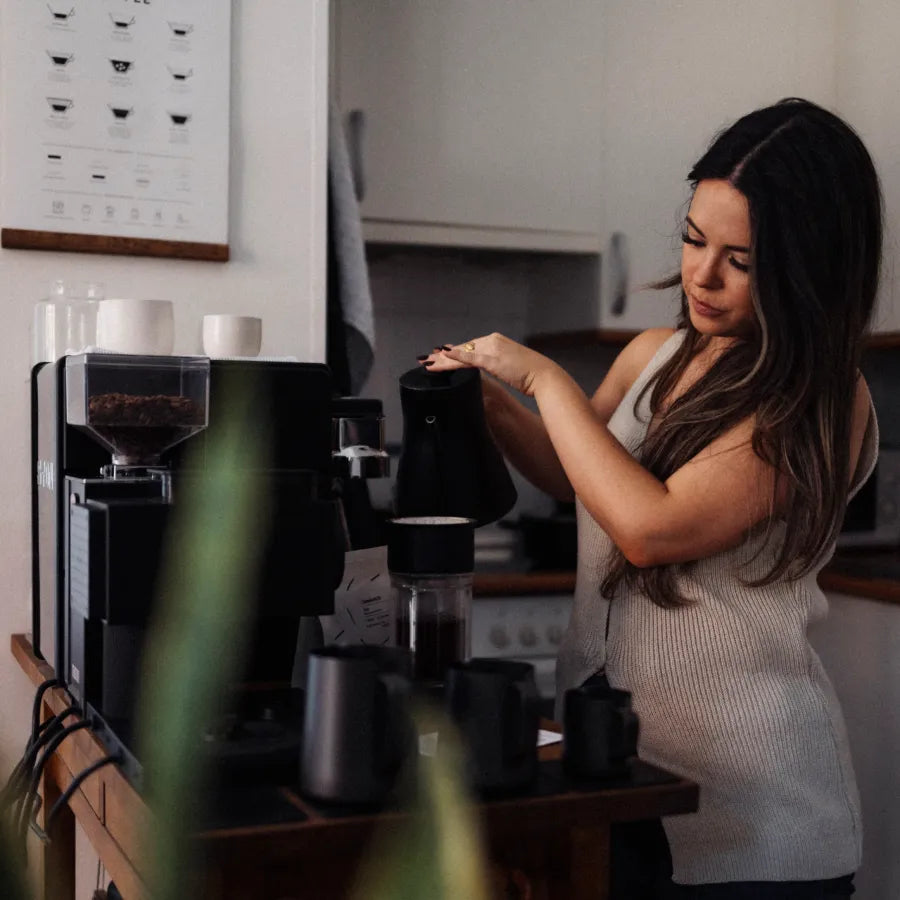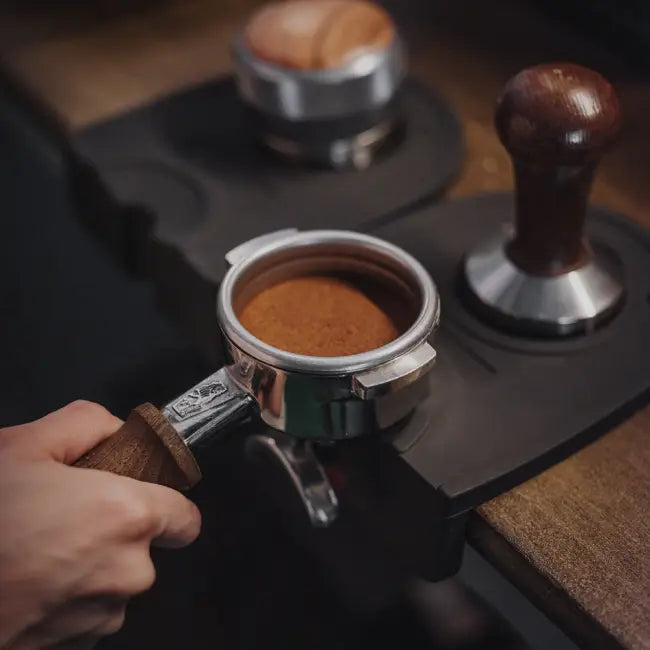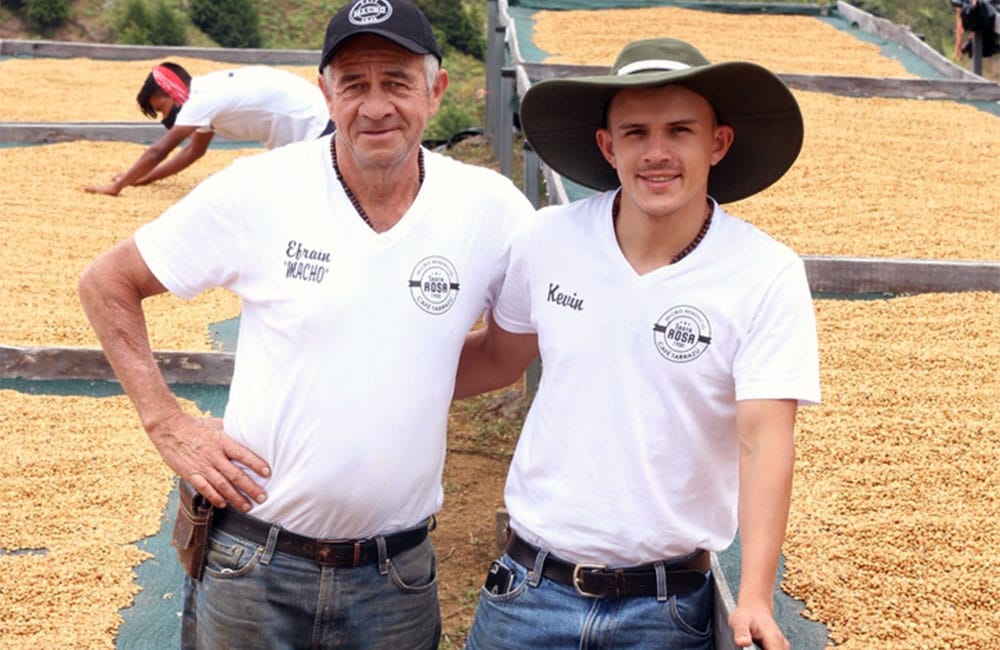Espresso. Chocolate, zarzamora, dátil
| Santa Ana | |
| 1.000 msnm. | |
| Bourbon, Pacas | |
| Natural anaeróbico 120h | |
| Rodolfo Ruffatti |

Café de la Finca Lombardía contra el cambio climático
Lombardía es el nombre de una de las fincas de la familia Ruffatti en El Salvador.
Está situada a 1.000 metros sobre el nivel del mar y se lleva cultivando café en ella desde 1970. La finca Lombardía está ubicada en la región de Santa Ana, donde tradicionalmente se ha cultivado café.
Ahora es una de las pocas fincas que quedan en esta región que mantienen este tipo de cultivo.
Gracias a esto ayuda a que se mantenga la biodiversidad necesaria para que las plantas de café crezcan en condiciones óptimas.
El origen de la finca Lombardía

La familia Ruffatti emigró de Italia a El Salvador alrededor de 1934 para dedicarse al cultivo del café y compró su primera finca llamada “El Salvador”.
En 1970 compraron la finca Lombardía, en la región de Santa Ana. Por aquel entonces casi todas las plantaciones de esta región se dedicaban al cultivo del café.
Desde entonces los beneficios del café han caído de forma dramática, conducidos por la especulación en los mercados financieros. A raíz de esto, muchos de los caficultores han tenido que cambiar de cultivo y ahora se dedican al maíz.
Del cultivo de café al maíz (y los efectos que esto ha tenido)

El cambio del cultivo del café al maíz ha tenido consecuencias desastrosas para el medio ambiente en esta región.
El cultivo del café necesita de una biodiversidad y vegetación que cree un microclima y árboles para sombra.
La calidad de la tierra también es muy importante y para esto es imprescindible una variedad rica de vegetación y un ecosistema equilibrado.
Debido a los pocos beneficios del cultivo del café en los últimos años muchos de los caficultores de esta zona han tenido que abandonar este cultivo y pasarse al maíz.
Para esto, han quemado grandes superficies de bosque y vegetación que antes se usaban para cultivar café llevando la región a una desertificación progresiva.
Además, el monocultivo de maíz necesita de pesticidas y químicos que empobrecen la calidad del terreno y la biodiversidad química de este.
Todo esto se debe a que el café es un producto que se compra y vende en los mercados financieros y con cuyo precio se especula en mercados de futuro.
La finca Lombardía apuesta por el café de especialidad

Para combatir esto la finca Lombardía ha apostado por el café de especialidad y un trato directo con los tostadores.
El cultivo del café de especialidad requiere de biodiversidad y un ecosistema equilibrado, por lo que la finca Lombardía se mantiene como un baluarte en contra de la desertificación y luchando por favorecer al medio ambiente.

Además, el café de especialidad y de trato directo repercute en mayores ganancias para los productores locales, lo que les permite una vida más digna y seguir manteniendo este tipo de cultivo que beneficia al medio ambiente y nos beneficia a todos.
Rodolfo Rufatti, nieto del Rodolfo Rufatti que inició a la familia Ruffatti en el cultivo del café en El Salvador, y quien está ahora a cargo del negocio familiar, está introduciendo más biodiversidad en la granja que, de forma indirecta, también beneficia a la calidad del café.
Procesado del café en la Finca Lombardía

En la finca Lombardía procesan el café siguiendo el método "natural".
Esto significa que las cerezas de café, una vez recogidas, se dejan secar en camas hasta que se alcanza la humedad deseada antes de ser despulpadas.
Este método confiere al café resultante un perfil afrutado pero limpio, equilibrado y dulce.
Cada lote es procesado individualmente y con sumo cuidado por el equipo de Productor Coffee bajo la supervisión de Rodolfo Ruffatti.
El proceso de fermentación anaeróbica

La fermentación anaeróbica es un proceso culinario muy usado con otros alimentos y bebidas, como el vino.
Consiste en dejar que la fruta, en este caso las cerezas de café, fermenten en tanques sellados herméticamente para que no entre oxígeno.
Estos tanques, además, tienen una válvula para expulsar el oxígeno que queda dentro.
Dentro de los tanques los microorganismos naturalmente presentes comenzarán a romper las moléculas de glucosa, una reacción química que genera CO² y calor.
Esto hará que se desplace el oxígeno en el tanque y sea expulsado por la válvula unidireccional.
Las bacterias que se encuentran de forma natural en la cereza de café y en el mucílago producen enzimas durante este proceso, que son las que hacen que se generen compuestos menos complejos, como ácidos orgánicos y alcohol.
Si quieres saber más sobre este proceso, puedes visitar nuestro artículo donde los explicamos en detalle la fermentación anaeróbica
Por qué se utiliza la fermentación anaeróbica y cómo se hace

La fermentación anaeróbica tiene un impacto sobre el perfil organoléptico del un café.
Esto hace que pueda modificar este perfil para mejorar algunas de las cualidades presentes en dicho café.
Una vez recogidas en su punto óptimo de maduración, las cerezas se dejan fermentar en tanques sellados herméticamente durante 120 horas.
En el caso de este café en concreto, el proceso se lleva a cabo en bolsas de plástico, esto puede variar con cada productor.
Las cerezas se pueden poner a fermentar despulpadas o sin despulpar, dependiendo del proceso que se vaya a aplicar después de la fermentación, lavado, natural o honey son los procesos habituales.
Para este lote natural se dejan secar las cerezas sin despulpar hasta conseguir el nivel de humedad deseado, aproximadamente 2 semanas.
Durante este tiempo deben de ser volteadas con regularidad para asegurar un secado uniforme.









